This post contains affiliate links. If you click through and make a purchase, we may earn a commission at no additional cost to you. Thank you for your support
Thank you for reading this post, don't forget to subscribe!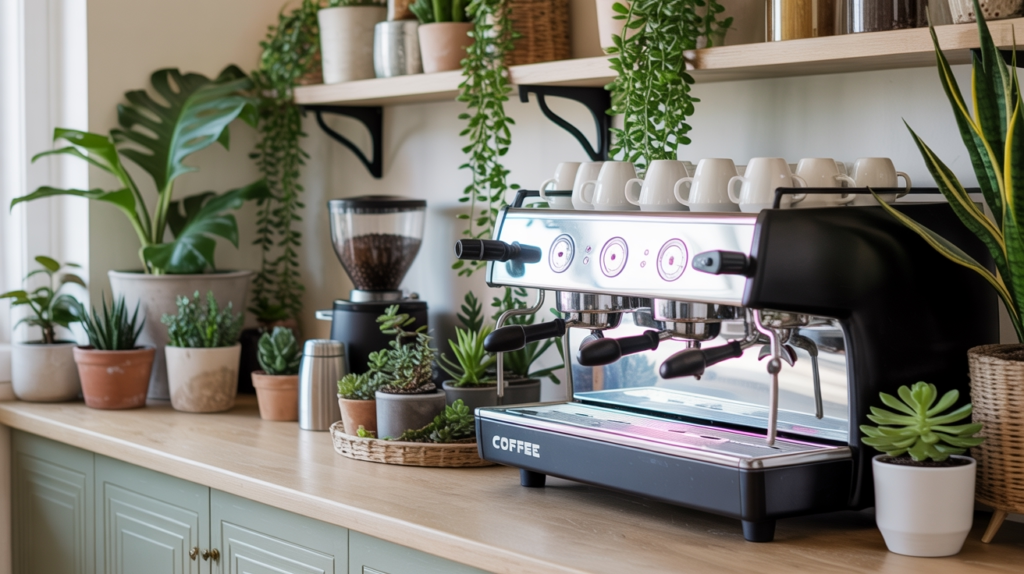
The ritual of brewing coffee transcends simple caffeine consumption—it’s a daily ceremony that sets the tone for your day, provides moments of pause, and offers opportunities for creativity and enjoyment. Creating a dedicated coffee bar in your home elevates this experience, transforming routine coffee preparation into an intentional, pleasurable practice while adding functional beauty to your kitchen or dining area.
A well-designed home coffee bar combines practical functionality with aesthetic appeal, housing everything needed for your perfect cup while serving as an attractive focal point in your space. Whether you’re a casual coffee drinker or a devoted enthusiast, the right accessories and thoughtful organization create coffee stations that inspire daily use and bring joy to your morning routine.
This comprehensive guide explores essential accessories for home coffee bars, from functional equipment to decorative elements, helping you create a personalized coffee station that reflects your style while supporting your brewing preferences.
Understanding Coffee Bar Fundamentals
Before selecting specific accessories, consider what makes a coffee bar truly functional and enjoyable. Successful coffee stations balance several key elements that work together to create seamless, satisfying experiences.
Location Considerations:
Kitchen Counter Space: The most common location, offering proximity to water sources and electrical outlets. Dedicate a specific counter section to coffee preparation, keeping equipment accessible and organized.
Dining Room Sideboard: Creates dedicated coffee station separate from kitchen work areas. This approach works beautifully for entertaining, allowing guests to serve themselves without entering kitchen spaces.
Home Office Nook: For remote workers, having coffee stations in office spaces eliminates trips to the kitchen, maintaining focus and productivity.
Breakfast Nook: Integrating coffee bars into breakfast areas creates natural morning gathering spots.
Essential Functional Elements:
Accessibility: Everything needed for coffee preparation should be within arm’s reach, eliminating unnecessary movement and streamlining the brewing process.
Organization: Designated spaces for each item prevent clutter and make finding supplies effortless.
Workflow: Arrange items in logical order following your brewing process—beans, grinder, brewer, cups, additions.
Maintenance: Easy-to-clean surfaces and accessible storage simplify upkeep, ensuring your coffee bar remains inviting.
Aesthetic Considerations:
Your coffee bar should complement your home’s overall design while reflecting your personal style. Consider: – Color schemes that coordinate with surrounding decor – Materials that match or complement existing finishes – Display methods that showcase beautiful equipment and accessories – Lighting that highlights your coffee station while providing adequate task illumination
Coffee Storage Solutions
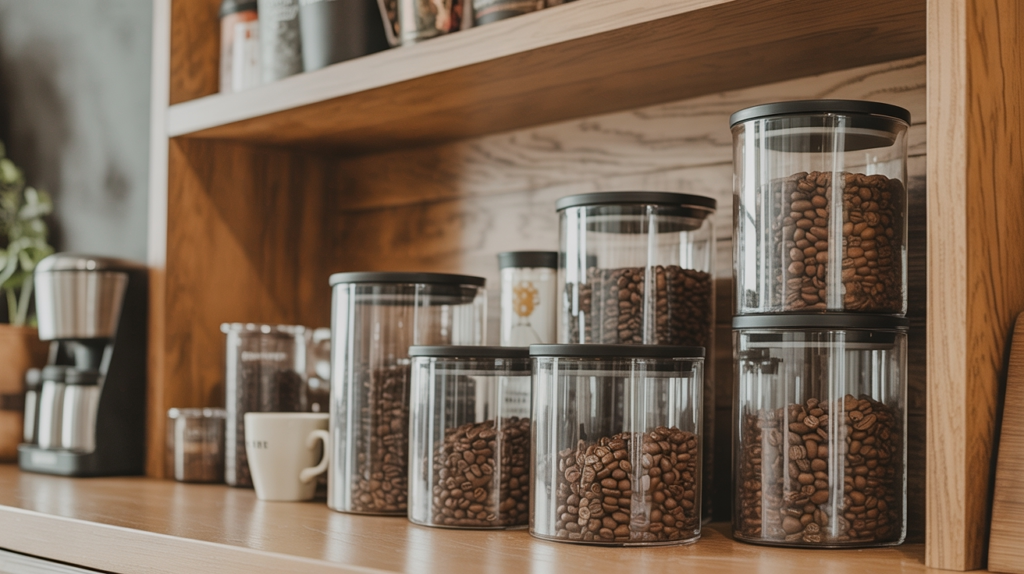
Proper coffee storage preserves freshness and flavor while contributing to your coffee bar’s visual appeal. The right storage containers protect beans from light, air, moisture, and heat—the four enemies of coffee freshness.
Coffee Canister Selection:
Airtight Seals: The most critical feature. Look for containers with silicone gaskets or locking mechanisms that create true airtight seals, preventing oxygen exposure that degrades coffee quality.
Opaque Materials: Light accelerates coffee staling. Choose opaque containers or store clear containers in dark locations.
Appropriate Sizing: Select containers that match your consumption rate. Smaller containers for beans you’ll use within two weeks; larger for bulk storage.
Material Options:
Ceramic Canisters: Offer excellent light protection and aesthetic appeal. Heavy construction provides stability. Available in countless styles from traditional to contemporary.
Stainless Steel: Durable and light-blocking. Modern appearance suits contemporary kitchens. Often features vacuum-seal technology for superior freshness.
Glass with Protective Coating: Allows you to see contents while UV-protective coatings minimize light damage. Best stored in cabinets or dark locations.
Organization Strategies:
Multiple Canisters: If you enjoy various coffee types, dedicate separate containers to each. Label clearly to distinguish between regular, decaf, flavored, or different roast levels.
Integrated Scoops: Choose canisters with built-in or attached scoops for convenient measuring.
Stackable Designs: Maximize vertical space with stackable containers, particularly useful in compact kitchens.
Display vs. Storage: Keep daily-use coffee in attractive canisters on display; store backup supplies in less decorative containers in pantries or cabinets.
Beyond Beans:
Don’t forget storage for coffee-related supplies: – Sugar and sweetener containers – Creamer or milk alternatives – Flavoring syrups – Stirrers and spoons – Filters and pods
Brewing Equipment Essentials
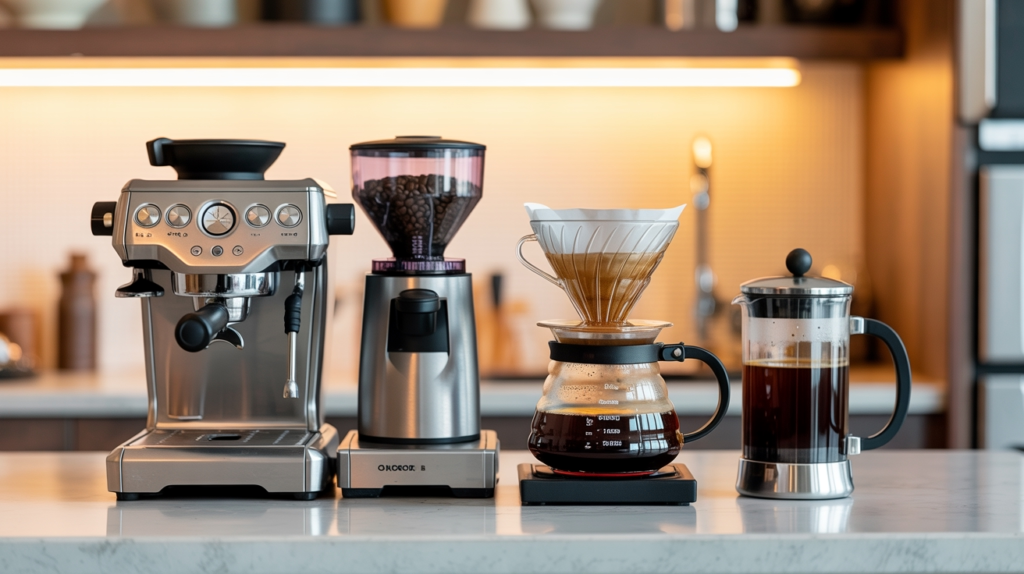
Your brewing method determines which equipment occupies your coffee bar. Understanding options helps you select tools that match your preferences and lifestyle.
Coffee Makers:
Drip Coffee Makers: Convenient for brewing multiple cups. Modern programmable models allow you to wake to fresh coffee. Choose models with thermal carafes to maintain temperature without burning coffee.
Pour-Over Systems: Offer control over brewing variables, producing clean, nuanced cups. Require more attention but provide meditative brewing experiences. Options range from simple plastic drippers to elegant glass or ceramic systems.
French Press: Immersion brewing creates full-bodied, rich coffee. Simple to use and clean. Available in various sizes and materials—glass, stainless steel, or ceramic.
Espresso Machines: For espresso enthusiasts, home machines range from manual lever models to automatic systems. Consider counter space, budget, and desired control level.
Single-Serve Systems: Pod-based machines offer convenience and variety. Environmental considerations have led to reusable pod options.
Cold Brew Makers: Specialized containers for steeping coffee in cold water, producing smooth, low-acid concentrate.
Grinder Selection:
Fresh-ground coffee dramatically improves flavor. Grinders fall into two main categories:
Burr Grinders: Crush beans between two abrasive surfaces, producing uniform particle sizes. Available in conical or flat burr designs. Offer grind size adjustments for different brewing methods. More expensive but superior results.
Blade Grinders: Chop beans with spinning blades, producing less uniform grounds. More affordable and compact. Adequate for drip coffee but less ideal for espresso or pour-over.
Grinder Considerations:
- Capacity: Match hopper size to your consumption
- Grind Settings: More settings provide greater brewing flexibility
- Noise Level: Some grinders operate more quietly than others
- Ease of Cleaning: Removable burrs or blades simplify maintenance
- Static Reduction: Some models minimize static cling that causes grounds to scatter
Kettle Options:
Electric Kettles: Rapid heating with automatic shut-off. Variable temperature models allow precise water temperature control for different coffee types.
Gooseneck Kettles: Narrow, curved spouts provide precise pour control essential for pour-over brewing. Available in stovetop and electric versions.
Standard Kettles: Traditional stovetop kettles work perfectly well for most brewing methods.
Temperature Control: Serious coffee enthusiasts benefit from kettles with built-in thermometers or temperature settings, as water temperature significantly impacts extraction.
Coffee Serving Essentials
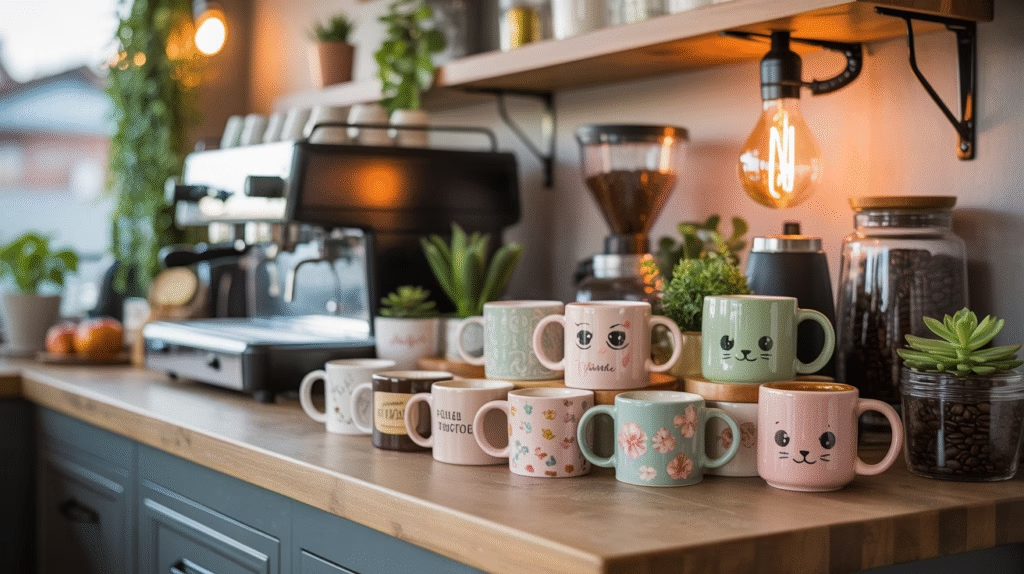
The vessels you drink from influence both coffee enjoyment and your coffee bar’s aesthetic appeal.
Mug and Cup Selection:
Material Considerations:
Ceramic: Classic choice offering excellent heat retention. Available in endless styles, colors, and designs. Dishwasher and microwave safe.
Porcelain: Refined and elegant. Thinner walls than ceramic while maintaining durability. Often features delicate designs or patterns.
Glass: Showcases coffee’s color and layers (important for lattes and cappuccinos). Double-walled versions provide insulation while remaining cool to touch.
Stainless Steel: Excellent heat retention and durability. Ideal for travel mugs or outdoor use. Modern designs suit contemporary aesthetics.
Size and Shape:
Standard Mugs (12-16 oz): Versatile size for most coffee drinks. Comfortable to hold with adequate capacity.
Espresso Cups (2-3 oz): Small, thick-walled cups designed for concentrated espresso. Often sold with matching saucers.
Cappuccino Cups (6-8 oz): Wider bowls accommodate foam while maintaining appropriate coffee-to-milk ratios.
Latte Bowls: Wide, shallow vessels traditional in European cafes. Comfortable to cradle in both hands.
Building Your Collection:
Daily Use Mugs: Select 4-6 mugs in coordinating styles for regular use. These should be dishwasher-safe and durable.
Special Occasion Cups: Keep finer china or unique pieces for entertaining or special moments.
Variety: Include different sizes and styles to accommodate various coffee drinks and moods.
Personal Expression: Choose mugs that reflect your personality—whether minimalist white, colorful patterns, or meaningful quotes.
Display Solutions:
Mug Racks: Wall-mounted or countertop racks keep mugs accessible while creating visual displays.
Open Shelving: Arrange mugs on shelves near your coffee bar for easy access and decorative appeal.
Hooks: Install hooks under cabinets or on walls for hanging mugs by handles.
Cabinets: Store less-frequently-used mugs in cabinets, keeping daily favorites on display.
Coffee Preparation Accessories
Beyond major equipment, numerous smaller accessories enhance coffee preparation and enjoyment.

Measuring Tools:
Coffee Scoops: Ensure consistent coffee-to-water ratios. Standard scoops hold approximately 2 tablespoons (10 grams) of ground coffee.
Digital Scales: Provide precise measurements for serious coffee enthusiasts. Accuracy improves consistency and allows recipe replication.
Measuring Spoons: Useful for adding sugar, creamer, or flavorings in controlled amounts.
Filters and Filtration:
Paper Filters: Disposable filters for drip coffee makers and pour-over systems. Choose bleached or unbleached based on preference.
Reusable Filters: Metal or cloth filters eliminate waste while allowing more oils into final cup, creating fuller body.
Water Filters: Coffee is 98% water—quality matters. Filtered water removes chlorine and impurities that affect taste.
Milk Frothing Tools:
Manual Frothers: Handheld devices that whisk milk into foam. Affordable and effective for small quantities.
Electric Frothers: Automatic frothing with minimal effort. Some heat milk simultaneously.
Steam Wands: Built into espresso machines, providing professional-quality microfoam.
French Press Method: Double-duty use of French press for frothing milk.
Stirring and Mixing:
Spoons: Long-handled spoons reach bottom of tall mugs. Choose materials that won’t scratch ceramic or glass.
Stirring Sticks: Disposable or reusable sticks for quick mixing.
Cocktail Stirrers: Decorative options for special occasions or entertaining.
Cleaning Supplies:
Brushes: Specialized brushes clean grinders, espresso machine group heads, and narrow containers.
Descaling Solutions: Remove mineral buildup from coffee makers and kettles, maintaining performance and extending equipment life.
Microfiber Cloths: Gentle cleaning for delicate equipment and surfaces.
Cleaning Tablets: Designed for espresso machines and coffee makers, removing oils and residue.
Sweeteners and Flavor Additions
Personalize coffee with various sweeteners, creamers, and flavorings, organized attractively on your coffee bar.

Sweetener Options:
Granulated Sugar: Classic choice available in white, brown, or raw varieties.
Sugar Cubes: Elegant presentation, particularly for entertaining.
Liquid Sweeteners: Honey, agave, or simple syrups dissolve easily in hot or cold coffee.
Alternative Sweeteners: Stevia, monk fruit, or artificial sweeteners for those reducing sugar intake.
Storage Solutions:
Sugar Bowls: Traditional covered bowls keep sugar fresh while adding decorative element.
Pour Spout Containers: Allow controlled dispensing of granulated sugar.
Pump Bottles: Convenient for liquid sweeteners, providing measured doses.
Creamer and Milk Options:
Fresh Dairy: Whole milk, half-and-half, or heavy cream stored in refrigerator.
Non-Dairy Alternatives: Almond, oat, soy, or coconut milk for dietary preferences or restrictions.
Flavored Creamers: Pre-flavored options in numerous varieties.
Powdered Creamers: Shelf-stable option for occasional use or emergencies.
Serving Solutions:
Cream Pitchers: Small pitchers keep cream at table or coffee bar.
Thermal Carafes: Maintain milk temperature for extended periods.
Pump Dispensers: Convenient for flavored syrups.
Flavor Additions:
Syrups: Vanilla, caramel, hazelnut, and seasonal flavors.
Spices: Cinnamon, nutmeg, cardamom, or cocoa powder.
Extracts: Vanilla, almond, or peppermint extracts for subtle flavoring.
Whipped Cream: Fresh or canned for indulgent treats.
Organizational Accessories
Proper organization keeps coffee bars functional and attractive, preventing clutter while maintaining accessibility.
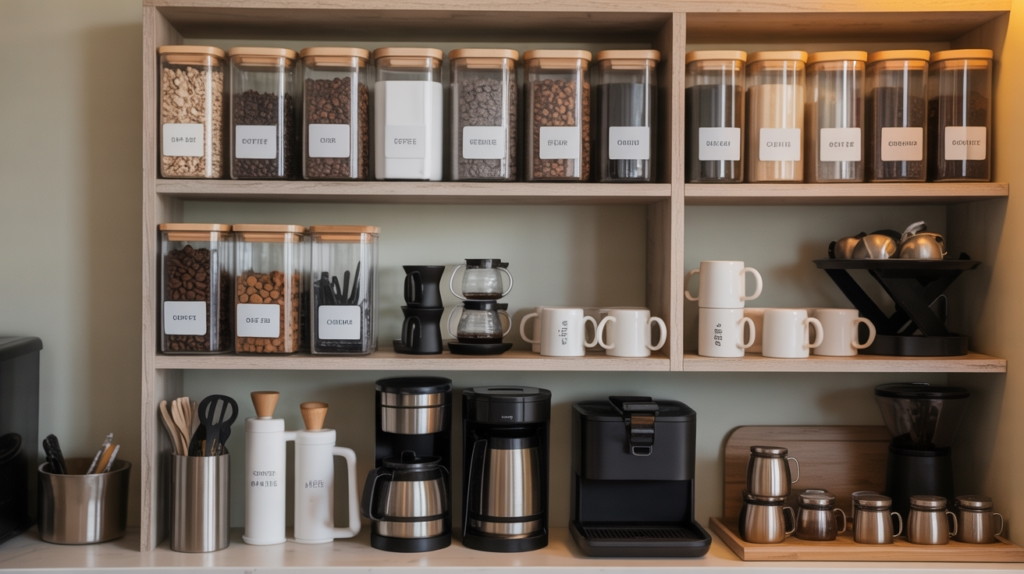
Trays and Caddies:
Serving Trays: Corral items on countertops, defining coffee bar boundaries while allowing easy relocation for cleaning.
Tiered Stands: Maximize vertical space, displaying items at different heights for visual interest and accessibility.
Lazy Susans: Rotating platforms provide easy access to items stored toward back of counters or in cabinets.
Drawer Organizers: Divide drawers into sections for filters, pods, stirrers, and other small items.
Shelving Solutions:
Floating Shelves: Mount above coffee bars for additional storage without consuming counter space.
Corner Shelves: Utilize often-wasted corner areas.
Bookcase Styling: Dedicate bookcase sections to coffee supplies and equipment.
Cabinet Organizers: Maximize cabinet space with shelf risers, pull-out drawers, or door-mounted racks.
Basket and Container Storage:
Woven Baskets: Natural texture adds warmth while concealing less attractive items.
Wire Baskets: Industrial aesthetic with visibility of contents.
Ceramic Containers: Decorative storage for pods, tea bags, or stirrers.
Glass Jars: Display colorful items like flavored syrups or decorative coffee beans.
Decorative Elements
Transform functional coffee bars into beautiful focal points through thoughtful decorative touches.
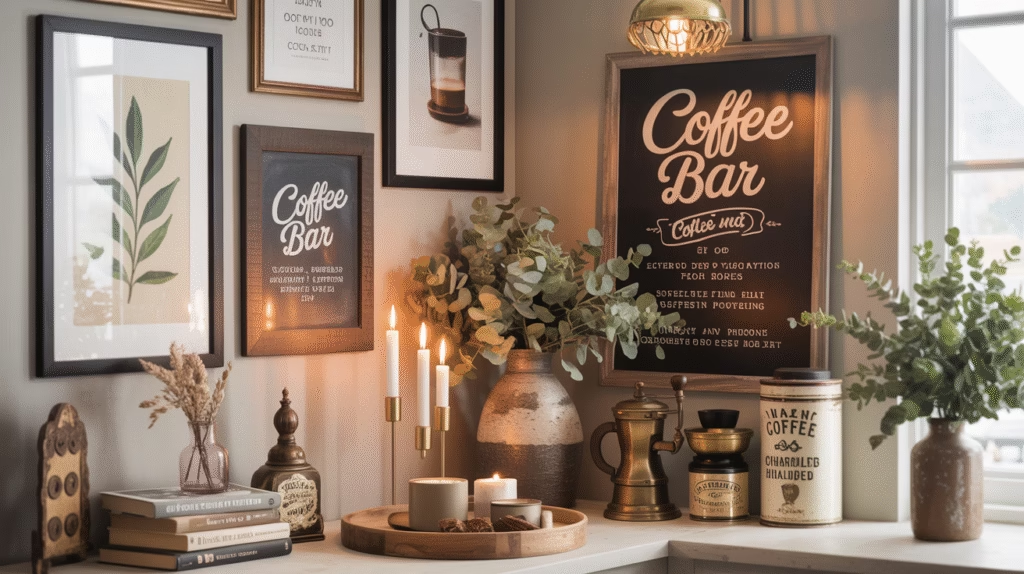
Artwork and Signage:
Coffee-Themed Art: Prints, paintings, or photographs celebrating coffee culture.
Chalkboard Signs: Customizable messages, quotes, or menu boards.
Vintage Advertisements: Retro coffee ads add nostalgic charm.
Typography Prints: Coffee-related quotes or phrases in attractive fonts.
Plants and Natural Elements:
Herbs: Small pots of mint or basil add freshness and provide garnishes.
Succulents: Low-maintenance plants add life without requiring frequent watering.
Fresh Flowers: Seasonal blooms bring color and natural beauty.
Branches or Greenery: Larger arrangements create dramatic focal points.
Lighting:
Under-Cabinet Lighting: Illuminates work surfaces while creating ambiance.
Pendant Lights: Hang above coffee bars for focused task lighting and visual interest.
String Lights: Add whimsical, cozy atmosphere.
Candles: Provide soft lighting and pleasant scents during evening coffee moments.
Textiles:
Tea Towels: Functional and decorative, available in countless patterns and colors.
Placemats: Define coffee bar area while protecting surfaces.
Napkins: Cloth napkins add elegance and reduce waste.
Coasters: Protect surfaces while adding decorative touches.
Personal Touches:
Collections: Display vintage coffee equipment, international coffee packages, or mug collections.
Travel Souvenirs: Coffee-related items from trips add personal meaning.
Family Photos: Include images of coffee moments or gatherings.
Seasonal Decor: Rotate decorative elements to reflect seasons or holidays.
Coffee Bar Styles
Design your coffee bar to complement your home’s overall aesthetic.
Modern Minimalist:
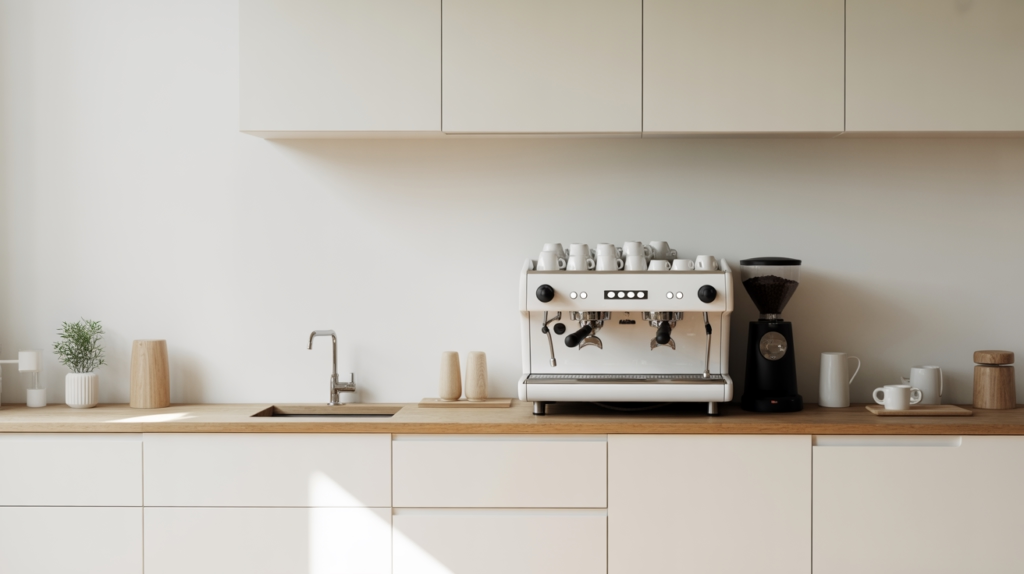
- Clean lines and simple forms
- Neutral color palette (white, black, gray)
- Concealed storage
- Sleek equipment in matching finishes
- Minimal decorative elements
Rustic Farmhouse:
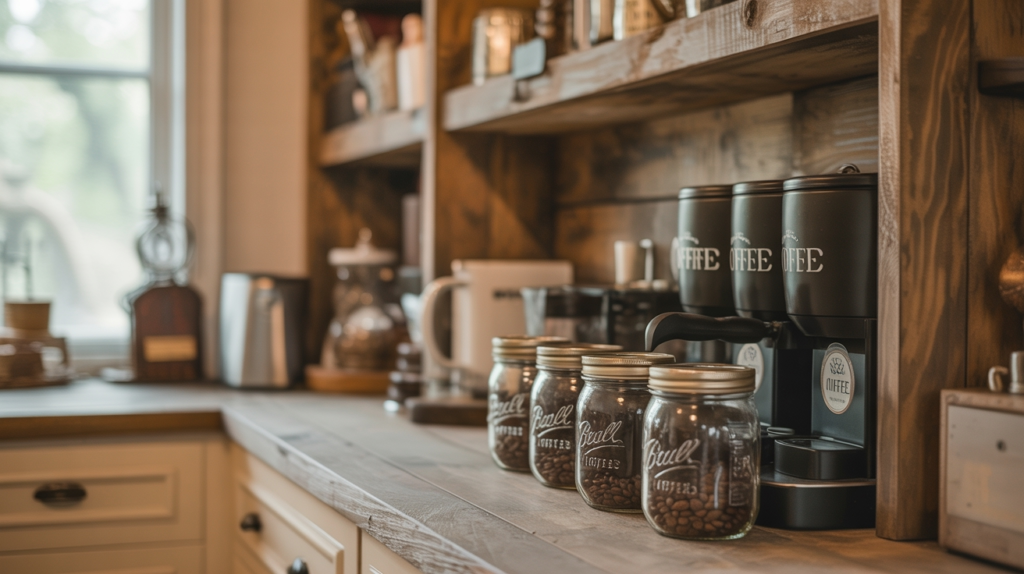
- Natural wood elements
- Vintage or vintage-inspired accessories
- Open shelving with woven baskets
- Enamelware and ceramic containers
- Warm, cozy textiles
Industrial:
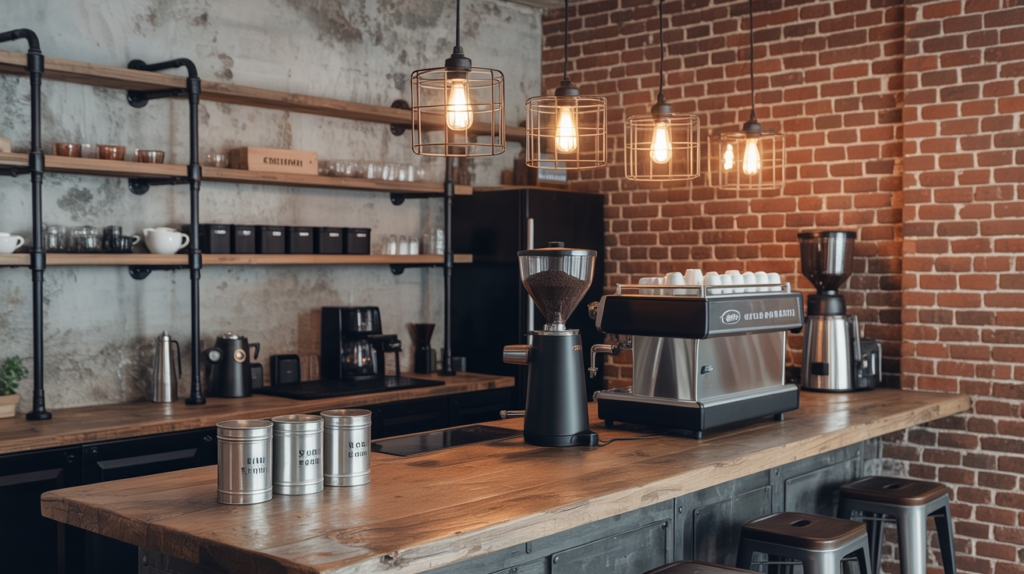
- Metal and wood combinations
- Exposed shelving and pipes
- Edison bulb lighting
- Utilitarian equipment
- Raw, unfinished materials
Traditional:
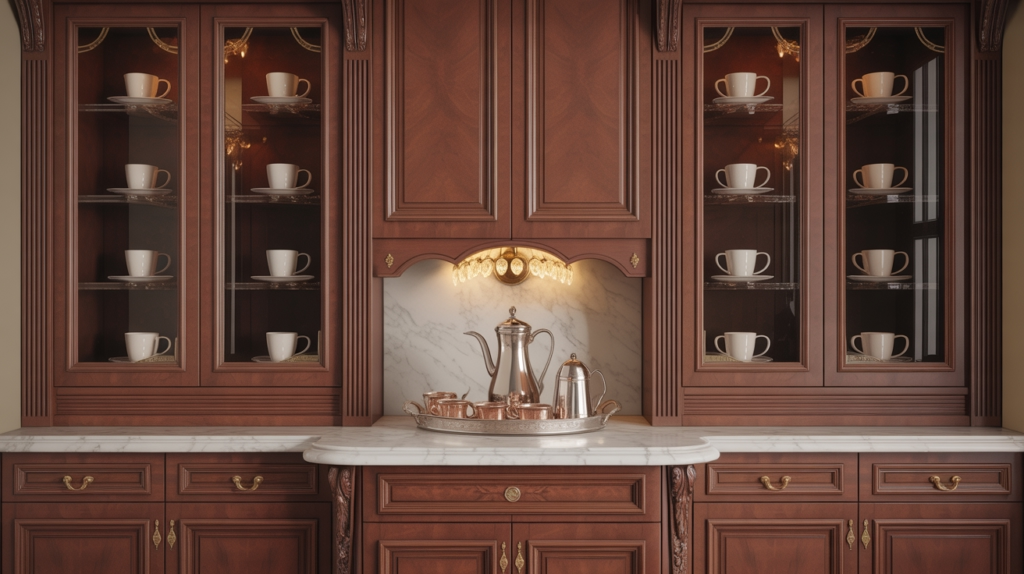
- Classic wood cabinetry
- Ornate details and moldings
- China and porcelain serving pieces
- Formal arrangement and symmetry
- Rich, warm color palette
Eclectic:
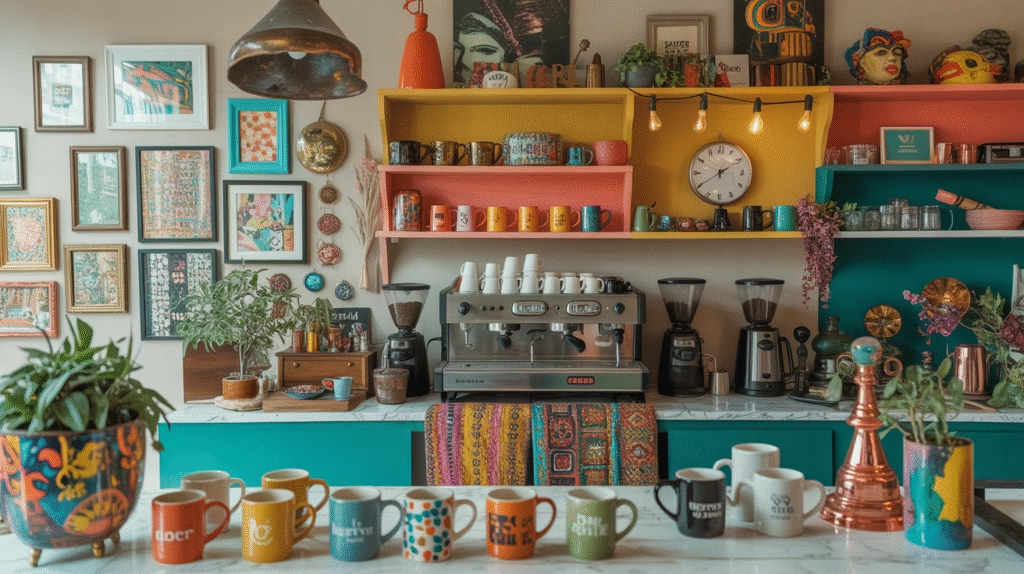
- Mix of styles and eras
- Colorful, varied accessories
- Personal collections on display
- Unique, one-of-a-kind pieces
- Layered, collected appearance
Maintenance and Care
Keep your coffee bar functional and attractive through regular maintenance.
Daily Tasks:
- Wipe down surfaces after use
- Rinse and dry equipment
- Empty and clean coffee maker
- Refill supplies as needed
- Quick organization of items
Weekly Tasks:
- Deep clean coffee maker according to manufacturer instructions
- Wash all mugs and accessories
- Wipe down canisters and containers
- Dust shelves and decorative items
- Check and restock supplies
Monthly Tasks:
- Descale coffee maker and kettle
- Deep clean grinder
- Organize and purge expired items
- Rotate and refresh decorative elements
- Assess and adjust organization systems
Seasonal Tasks:
- Update decorative elements
- Deep clean entire coffee bar area
- Assess equipment condition and replace if needed
- Reorganize based on changing needs
- Refresh textiles and accessories
Budget-Friendly Coffee Bar Creation
Create beautiful, functional coffee bars without significant investment.
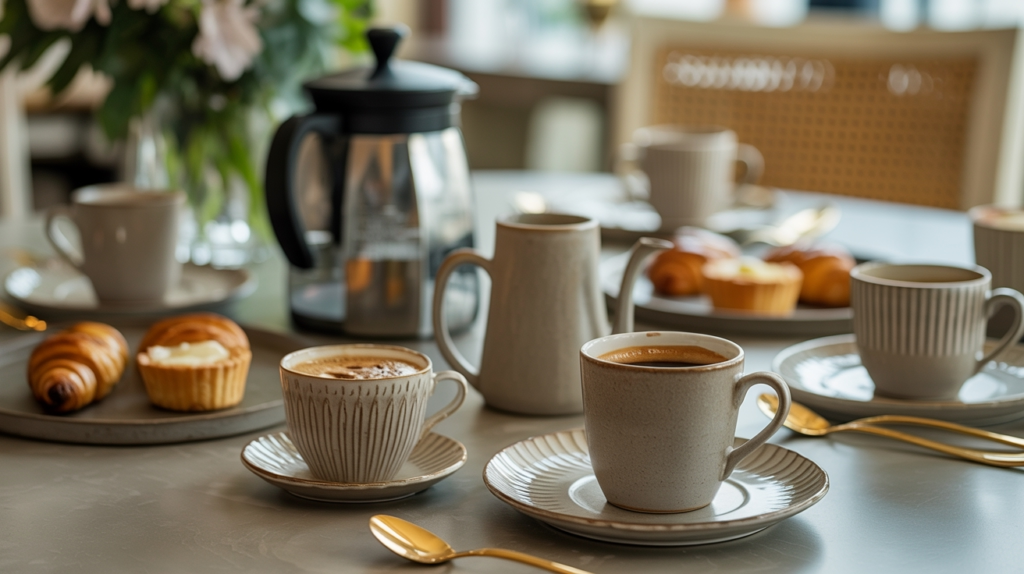
Prioritize Essentials:
Invest in quality brewing equipment and storage, using budget-friendly options for decorative elements.
Repurpose and DIY:
- Use existing furniture as coffee bar base
- Repurpose jars and containers for storage
- Create DIY artwork or signs
- Paint or refinish thrifted items
Shop Strategically:
- Purchase equipment during sales
- Buy decorative items at discount stores
- Thrift vintage accessories
- Use coupons and rewards programs
Start Small:
Build your coffee bar gradually, adding items as budget allows rather than purchasing everything at once.
Focus on Function:
Prioritize items that improve coffee quality and preparation efficiency over purely decorative elements.
Conclusion
Creating the perfect home coffee bar combines functional necessity with aesthetic pleasure, transforming daily coffee preparation into an intentional, enjoyable ritual. Through thoughtful selection of essential accessories—from storage solutions to brewing equipment, serving vessels to organizational tools—you build a personalized coffee station that reflects your style while supporting your coffee preferences.
The most successful coffee bars balance beauty with functionality, providing everything needed for perfect cups while serving as attractive focal points in your home. Whether you prefer minimalist modern aesthetics or cozy farmhouse charm, the right accessories and thoughtful organization create spaces that inspire daily use and bring joy to your morning routine.
Remember that coffee bars evolve over time. Start with essentials and gradually add accessories as you discover what enhances your experience. The perfect coffee bar isn’t about having every possible accessory—it’s about creating a space that works for your lifestyle, reflects your personality, and makes your daily coffee ritual something to look forward to.
Your ideal coffee bar awaits, ready to transform ordinary mornings into extraordinary moments of pleasure, one perfectly brewed cup at a time.